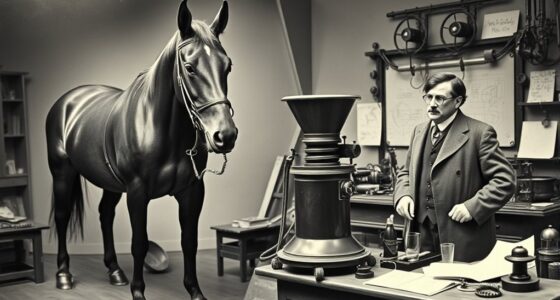Laundry technology has evolved from ancient hand scrubbing and washboards to modern, automated machines that save time and water. In the 19th century, mechanical devices made washing easier, while the 20th century introduced electric, pattern-controlled washers. Today’s smart appliances feature sensors, eco-friendly options, and remote connectivity. If you want to see how each innovation shaped cleaner, faster laundry routines, keep exploring this fascinating progress through the ages.
Key Takeaways
- Laundry technology evolved from manual methods like soaking and scrubbing to the invention of the washboard, improving efficiency and cleanliness.
- The 19th century saw the rise of mechanical devices such as wash boilers and rotary washers, marking automation’s beginning.
- Electric washing machines introduced motor-driven agitation, automatic cycles, and water heating, significantly reducing manual effort.
- Modern appliances now feature digital controls, sensors, eco-friendly options, and smart connectivity for enhanced convenience and sustainability.
- Future innovations include smart, resource-efficient machines and laundry robots, streamlining routines and minimizing environmental impact.
Early Methods of Washing Clothes in Ancient Times

In ancient times, people relied on simple yet effective methods to clean their clothes. You’d start by soaking garments in water, often infused with natural cleaning agents like ash or plant extracts. To brighten or add color, clothing dyes made from plants, minerals, or insects were used, giving textiles vibrant hues. Soap making was an essential skill; early soaps were crafted from animal fats combined with ashes, creating a basic cleaning agent. These soaps helped loosen dirt and oils, making washing more efficient. You’d scrub clothes by hand, sometimes using stones or wooden paddles to aid the process. While primitive compared to modern appliances, these methods effectively maintained clothing hygiene, relying on natural resources and ingenuity to keep garments clean and colorful. Color accuracy played a vital role in maintaining the vibrancy of dyed textiles in ancient washing practices.
The Invention and Popularity of the Washboard
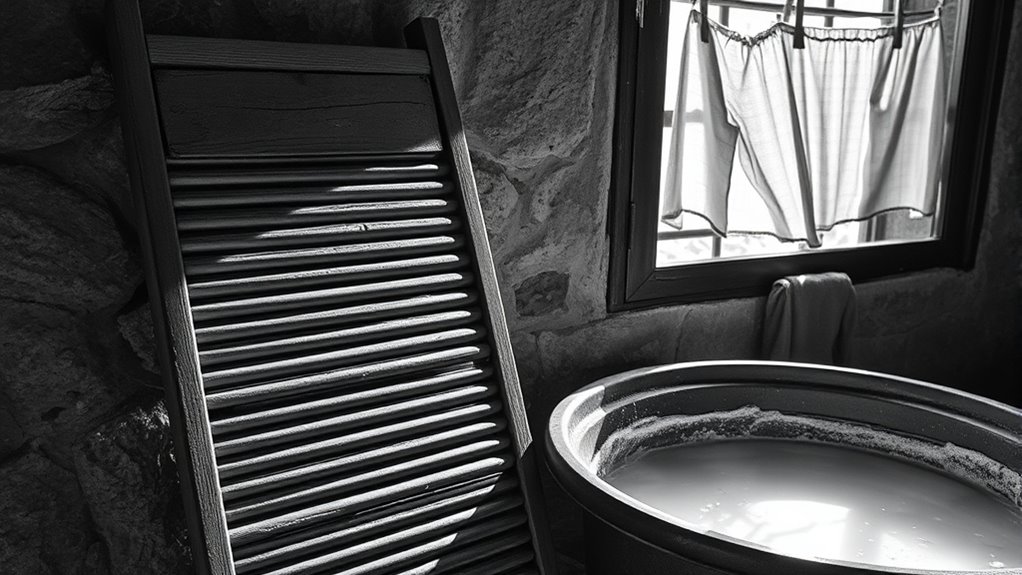
As laundry techniques evolved from soaking and scrubbing with stones, the need for more efficient methods led to the invention of the washboard. This simple tool revolutionized laundry routines, making clothes cleaner and saving time. You’d often see folks scrubbing vigorously, ensuring dirt and stains disappeared. Its popularity grew because it improved laundry etiquette—clothes looked fresher and tidier. To keep it effective, washboard maintenance was key: removing rust, replacing worn surfaces, and cleaning debris. Regular cleaning and proper storage extended its lifespan and ensured consistent performance. Visualize the textured surface, the wooden frame, and the water-soaked cloths stretched across it. As the washboard gained fame, it became a household staple, especially in rural areas, symbolizing progress in laundry technology and community effort. Its simplicity made laundry chores faster and more effective, transforming how people managed their clothing care.
The Rise of Mechanical Wash Devices in the 19th Century
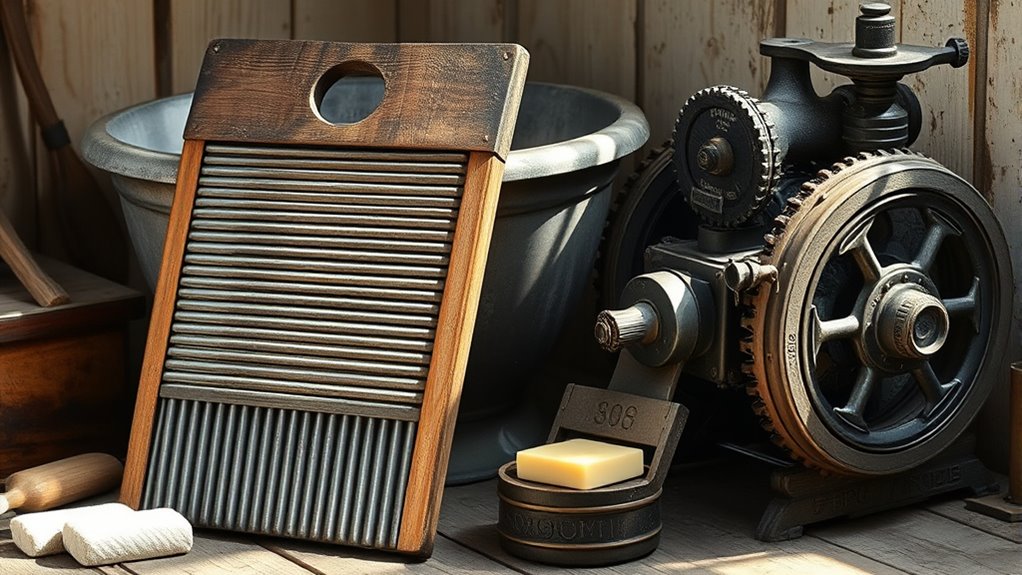
The 19th century marked a pivotal shift in laundry technology as mechanical wash devices began to replace manual methods, transforming household chores. Mechanical innovations like wash boilers, hand-powered machines, and rotary washers emerged through advances in industrial manufacturing. These devices increased efficiency and reduced physical effort, making laundry less labor-intensive. As factories mass-produced these machines, their affordability and availability grew, allowing more households to adopt them. You’d notice how this period introduced the first steps toward automation, setting the stage for future developments. The focus was on creating durable, practical devices that could handle larger loads, ultimately easing the burden of laundry. This era marked a significant leap from simple tools to more sophisticated mechanical systems, revolutionizing household routines across the world. Furthermore, the integration of sustainable materials in the manufacturing process began to influence the design and durability of these early appliances.
The Development of Electric Washing Machines
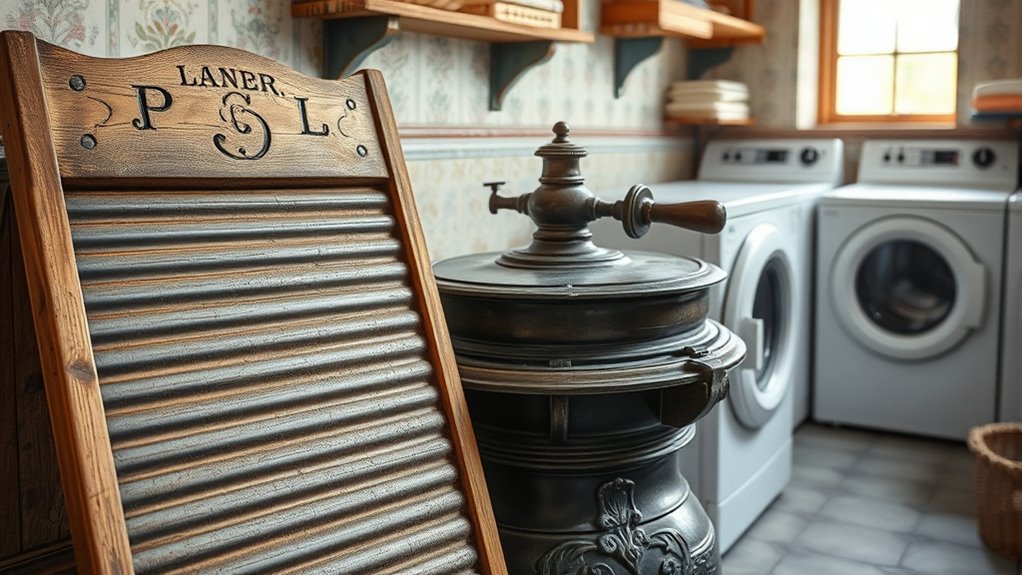
Building on the advancements of mechanical wash devices, the quest for even greater efficiency led to the development of electric washing machines. These machines introduced motor-driven agitation, replacing manual effort, and allowed for more consistent cleaning. Water heating, once a manual task, became integrated into the machine, ensuring warm water for better stain removal. You’ll notice:
- The drum spinning automatically, mimicking agitation but with less effort
- Water heating elements that maintain ideal temperatures
- Cycles that combine washing, rinsing, and spinning seamlessly
- The sound of an electric motor replacing manual scrubbing
- Kia Tuning innovations influencing modern appliance technology, such as precise control systems and performance enhancements.
This leap made laundry faster and less labor-intensive, transforming household chores. The electric washing machine set the foundation for future innovations, making clean clothes more accessible to everyone.
Innovations in Washing Technology During the 20th Century
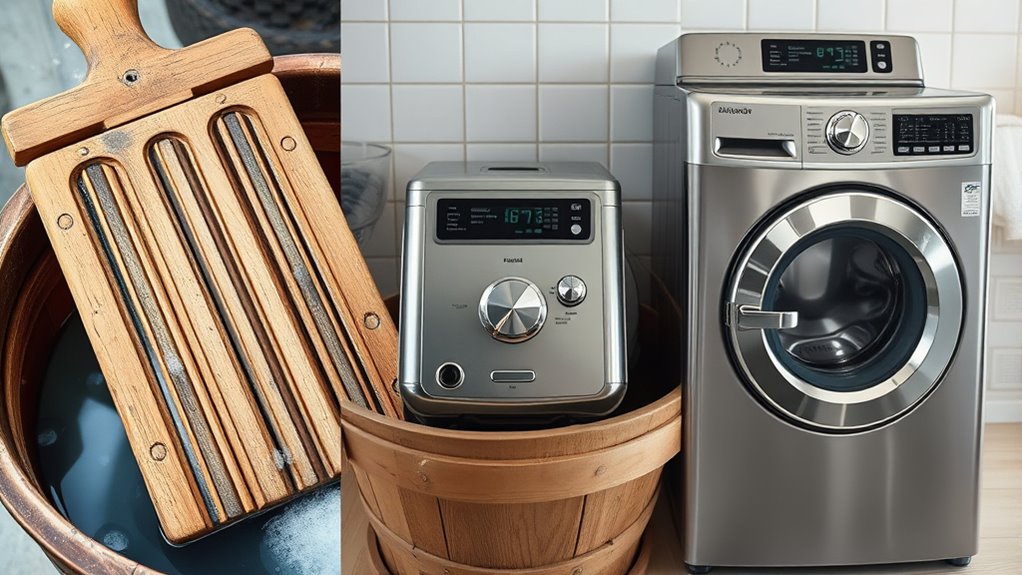
Throughout the 20th century, washing machines saw rapid innovation that dramatically improved their performance and convenience. You no longer needed harsh soaps; instead, laundry detergents became more effective, gentle, and specialized for different fabrics. This evolution helped clean clothes better while protecting delicate fibers. Fabric softeners also emerged, making garments feel smoother and smell fresher after washing. Innovations like automatic timers, multiple wash cycles, and spin speeds gave you more control and efficiency. These advancements reduced manual effort and minimized wear on fabrics. As a result, laundry became faster, more thorough, and less damaging to clothes. The development of vintage decor and the integration of nostalgic design elements in appliances further enhanced the aesthetic appeal of laundry spaces. You now enjoy cleaner, softer laundry with less time and effort, thanks to the ongoing development of detergents and fabric conditioners during the 20th century.
The Emergence of Modern, Automated Laundry Appliances

As laundry detergents and fabric conditioners became more effective, the focus shifted toward making the washing process even more effortless and efficient. Modern, automated laundry appliances revolutionized how you clean clothes, eliminating the need for hand washing and manual scrubbing. These machines use advanced cycles and sensors to optimize cleaning and water usage. Imagine opening a sleek, digital control panel, pressing a button, and watching your laundry turn from dirty to clean in a fraction of the time. You can picture:
- A washing machine filling with water automatically
- The agitator moving clothes gently but thoroughly
- Detergent dispensers releasing precise amounts
- The drum tumbling clothes seamlessly
This shift made laundry less labor-intensive, more consistent, and accessible for everyone. It marked a significant leap from manual methods to automated convenience. Regular maintenance of appliances and understanding sound therapy techniques can further enhance the longevity and performance of your laundry equipment.
The Impact of Digital and Smart Features on Laundry Machines
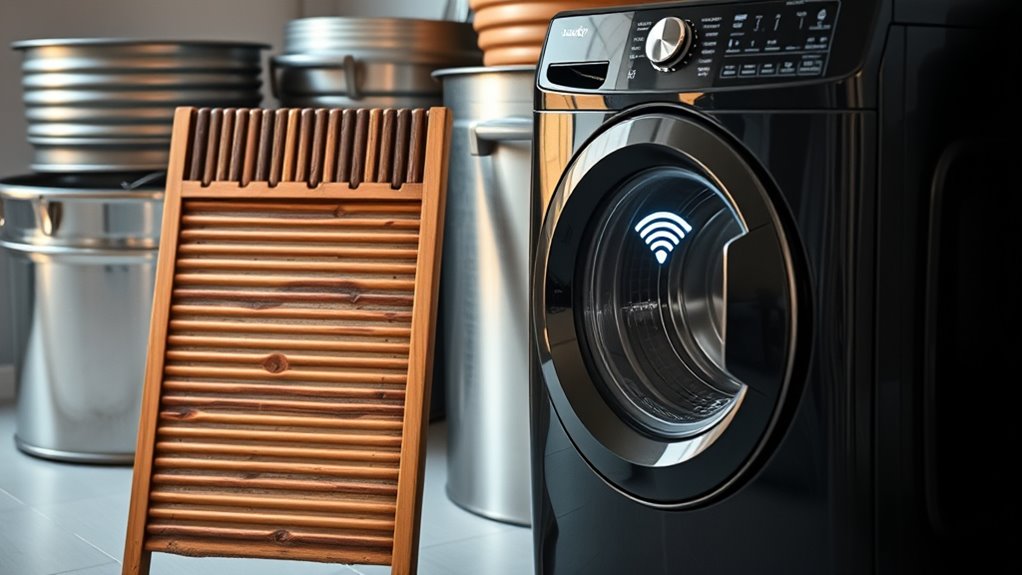
Have you ever wondered how your laundry machines seem to know exactly what they need to do? That’s thanks to smart sensors that detect load size, fabric type, and soil level, automatically adjusting water and cycle settings. App connectivity takes this further, letting you control and monitor your washer from your phone, even when you’re away. You can start a cycle, get notifications when it’s done, or troubleshoot issues without opening the machine. These digital features make laundry more convenient and efficient, reducing waste and saving time. By integrating smart sensors and app connectivity, modern laundry machines adapt seamlessly to your needs, transforming a routine chore into a smarter, more connected experience. Additionally, advancements in smart technology have enabled these appliances to learn from usage patterns, further optimizing performance over time.
Environmental Considerations and Energy Efficiency in Laundry Technology
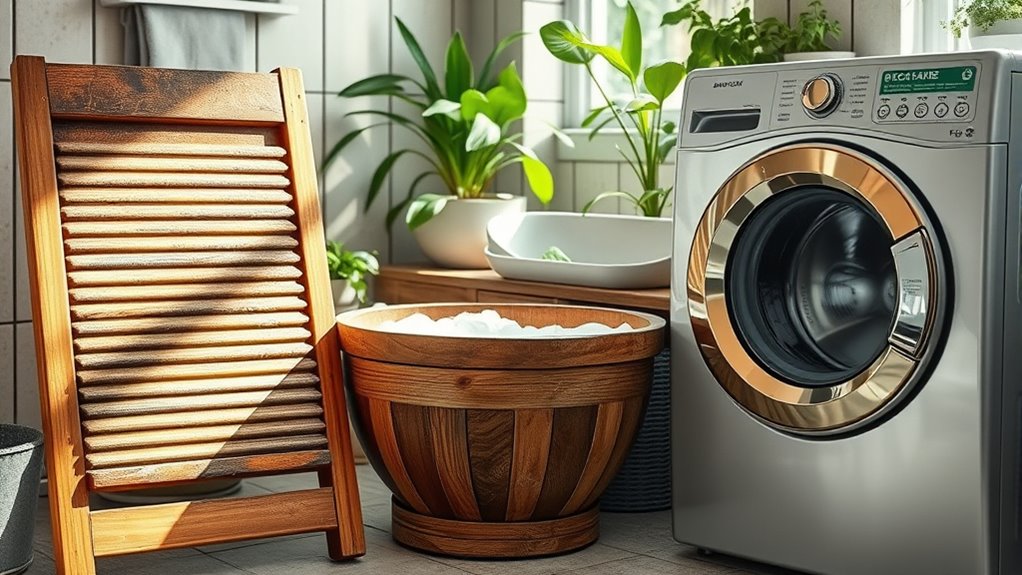
Modern laundry technology prioritizes environmental sustainability by designing machines that use less water and energy without sacrificing cleaning performance. With water conservation in mind, many new washers feature cycle options that minimize water use while still removing dirt effectively. Energy-efficient models reduce electricity consumption, helping lower your carbon footprint. You can also choose eco-friendly detergents that are gentle on the environment yet tough on stains. Additionally, some models incorporate vetted ice cream hater technology that ensures optimal performance while minimizing resource use. Picture:
- A sleek washing machine with a water-saving sensor
- Detergent pods that dissolve quickly and efficiently
- A cycle indicator showing reduced water and energy use
- A laundry room with a modern, eco-conscious setup
These innovations make your laundry routine more sustainable, saving resources and supporting eco-friendly practices every time you wash.
Future Trends and Innovations in Laundry Care
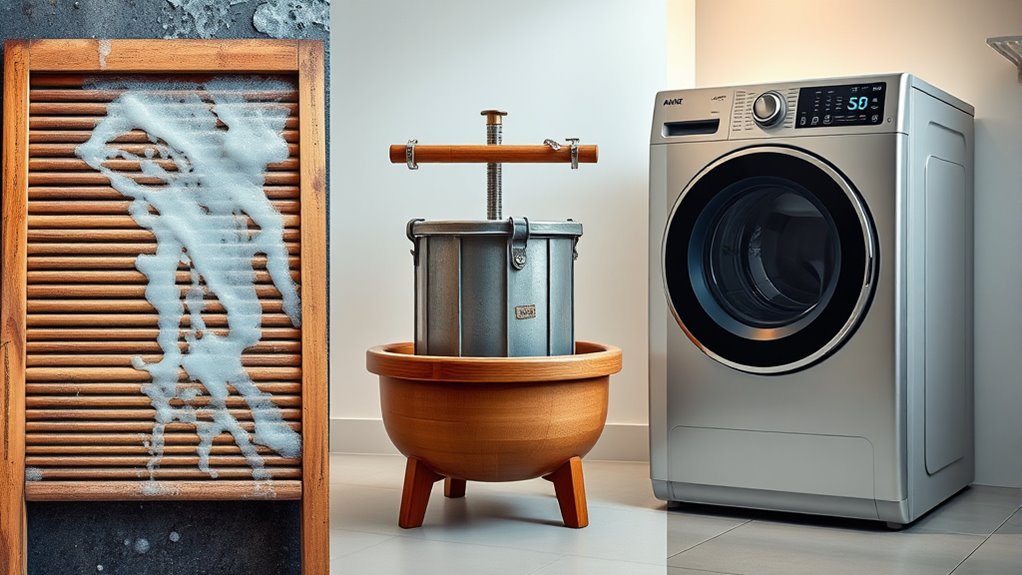
Looking ahead, laundry care is set to become even more intelligent and personalized through advancements in technology. Expect smart machines that adapt wash cycles based on fabric and stain type, reducing waste and energy use. Biodegradable detergents will gain prominence, making laundry eco-friendly without sacrificing cleaning power. Laundry robot assistants will become common, helping with sorting, loading, and even folding clothes, saving you time. These innovations will streamline your laundry routine and minimize environmental impact. Emerging laundry technologies will further enhance efficiency and sustainability in the near future.
Frequently Asked Questions
How Did Laundry Practices Vary Across Different Ancient Cultures?
You’ll see that laundry practices varied greatly across ancient cultures. In Egypt, people used natural dyes for clothing dyeing and had elaborate laundry rituals involving soaking and scrubbing with natural abrasives. In China, laundry included specific rituals to purify garments, while in Greece, communal washing and fabric care were common. These diverse methods reflect each culture’s unique approaches to cleanliness, dyeing techniques, and the importance they placed on laundry rituals.
What Materials Were Used in Early Laundry Tools Besides the Washboard?
You’ll find that early laundry tools used a variety of materials besides the washboard. Materials and innovations like stones, wooden paddles, and pumice stones helped people scrub clothes effectively. Some cultures used brushes made of animal hair or plant fibers for gentle cleaning. These innovations reflect resourcefulness and adaptation, allowing you to clean clothes with available materials before the advent of modern washing machines.
How Did Societal Changes Influence Laundry Technology Development?
Societal changes, like urbanization and women’s increased workforce participation, drove laundry tech development. You’ll see socioeconomic impacts, such as demand for faster, more efficient methods, prompting innovations like electric washing machines. Technological diffusion spread these innovations across communities, making laundry less labor-intensive. These changes reflect society’s evolving needs, pushing manufacturers to develop tools that save time and effort, ultimately transforming laundry routines into more manageable, efficient tasks.
What Role Did Women Play in Advancing Laundry Innovations?
Did you know women pioneers made up over 70% of early laundry innovation champions? As you explore laundry history, you’ll see women played a crucial role in advancing technology. Their hands-on experiences and inventive ideas pushed innovations, from new washboard designs to early electric washers. Women’s leadership in this field helped shape the modern laundry industry, proving their essential influence in turning everyday chores into more efficient, less labor-intensive tasks.
Are There Cultural Traditions Still Using Ancient Laundry Methods Today?
You might still observe cultural traditions that use ancient laundry methods today, especially in traditional garment care and ritualistic washing practices. In some communities, people preserve these methods to honor their heritage, such as hand-washing delicate fabrics or performing specific rituals before cleaning. These practices connect them to their history and cultural identity, demonstrating how ancient techniques remain meaningful even in a modern world focused on convenience.
Conclusion
As laundry technology continues to evolve, you’ll find your routine becoming easier and more eco-friendly. Imagine a smart washer that automatically adjusts water and energy use based on your load, saving you money and helping the planet. Just like that hypothetical family who reduced their energy bills by 30%, embracing these innovations can transform your laundry day into a faster, greener experience. The future of laundry is smarter, cleaner, and more efficient—are you ready to join the revolution?





